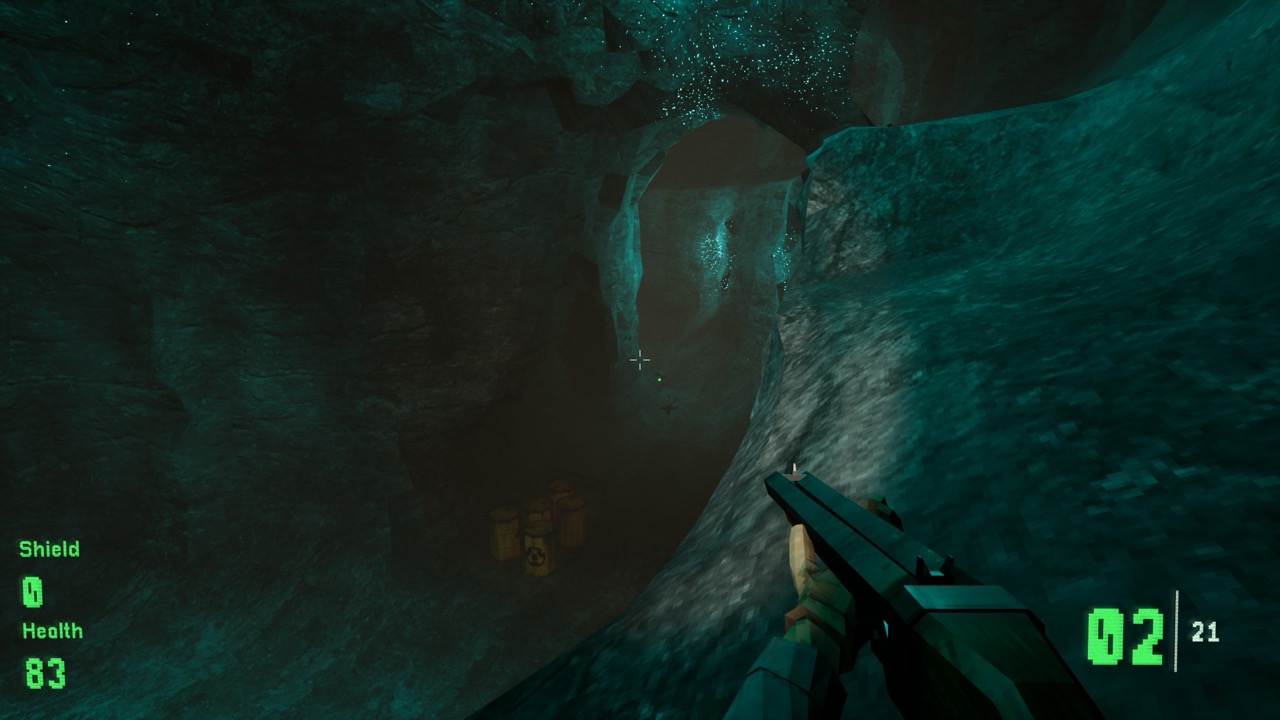KVARK delivers a tightly crafted, highly atmospheric shooter dripping with personality
Every once in a while, a game hits a very specific nerve — not necessarily because it’s perfect, but because it understands a vibe so thoroughly that you can’t help but fall in love with it. Kvark is that game for me. A retro-futuristic, Eastern Bloc fever dream that combines the oppressive atmosphere of Cold War-era industrialism with boomer shooter energy and a healthy dose of mutant dismemberment. And let me just say it up front: I loved every second of it.
This is the kind of experience that makes you feel nostalgic for a past you never lived through — one where you might’ve been a disgruntled scientist or security grunt in a crumbling underground facility somewhere in 1980s Czechoslovakia, flashlight in hand, shotgun at the ready, surrounded by rusted steel, buzzing lights, and the screeches of things that should not exist.

The game starts off with little fanfare. You wake up in the bowels of the Kvark facility, disoriented, confused, and immediately plunged into a grim world where something has clearly gone very wrong. There’s a tangible sense of dread as you explore the first corridors — lights flicker, pipes hiss, and you hear a disembodied voice through the facility’s intercom system. You’re not alone, and soon you’ll wish you were. It's all very original Half-Life and this is not the last time you'll hear that.
The story unfolds subtly, through environmental storytelling, some soviet era propaganda "ads" and short terminal logs. There’s no heavy-handed exposition or constant chatter — and that’s a good thing. The world of Kvark feels lived in. It’s crumbling, worn-down, and teetering on the edge of total collapse. As you dig deeper into the facility and its adjacent mines, you start piecing together what happened here — experiments gone wrong, shady military interventions, perhaps something worse. It’s never spelled out in neon lights, and that restraint adds a ton to the atmosphere.

Let’s talk about the gameplay — the meat of Kvark. This is where the game absolutely nails the old-school shooter formula. It’s tight, punchy, and at times brutal. The first few weapons you get your hands on might feel a little basic, but the arsenal expands nicely and every gun feels like it has a purpose. From the satisfying crack of the pistol (which sounds almost like it was ripped straight out of 1998 Half-Life) to the glorious chaos of the double-barreled shotgun, the combat has a weight to it that feels incredibly satisfying.
Enemy variety ramps up as you go. At first, it’s just mutant rats and skittering spiders, but before long, you’re dealing with humanoid mutants, hazmat-wearing creeps who rush you, shotgun-toting enemies who’ll delete your health bar if you’re not careful, and even cold, mechanical killing machines in the form of armed robots. The human mutants have also some pretty over-dramatic death animations that I kinda loved.
Watch this TikTok video
That being said, the PS5 gunplay took a bit of adjusting. Out of the box, it felt stiff and weird, almost like the aim assist was working against me. Disabling it and cranking up the sensitivity made a huge difference. Once I got it dialed in, it felt way more fluid, and I started hitting that rhythm where everything just clicks. If you’re playing on console, take a minute to tweak those settings — it’s worth it.

If you’ve ever played Half-Life, you’ll feel right at home here. The level design in Kvark borrows a lot from that school of design — mostly linear progression peppered with detours, locked doors, and multi-switch puzzles. But it never feels like a slog. In fact, I really appreciated how each chapter brought something different to the table.
Some levels are tight and claustrophobic, forcing you into nerve-wracking close-quarters encounters. Others open up slightly, letting you tackle objectives in whatever order you choose. One of the later chapters even goes semi-open, letting you explore four different objective zones scattered around a larger hub. It’s a great change of pace, and it shows the developers are willing to break up the formula to keep things fresh.
What’s also neat is how natural the progression feels. You rarely feel like you’re just walking down a corridor shooting things. You’re always doing something — flipping switches, solving light puzzles, uncovering secret vents or storage rooms. And when the action hits, it hits hard.

Now let’s talk about the other star of the show: the aesthetic. Kvark is drenched in Sovietcore vibes. From the brutalist architecture to the utilitarian terminals and the outdated tech scattered everywhere. The textures are low-poly, but don’t mistake that for a lack of detail. This game oozes personality from every rusty grate, every faded poster, every broken-down workstation. It’s a style that knows exactly what it is and leans into it with confidence.
Even the UI plays into the vibe — it’s clean but intentionally dated, clearly modeled after old CRT monitor overlays. The energy stations mounted on walls hum with that same warm, weird energy that fans of Half-Life will recognize immediately.

Kvark uses darkness masterfully, not just to hide enemies, but to create tension. Your flashlight becomes very important in darker sections, and when the power flickers and your visibility drops, your heart will start racing. Combine that with a haunting ambient soundtrack and unsettling enemy noises echoing in the distance, and you’ve got a recipe for atmosphere so thick you could cut it with a pipe wrench. Don't get me wrong though, this is not a scary game. If you give me a double-barreled shotgun that blows up a mutant into a million pieces, I'm not going to be scared.
On top of the gunplay and exploration, there’s a simple progression system layered in. Throughout the levels, you’ll find a currency that you can spend to unlock perks — stat buffs like increased rate of fire speed, more headshot damage, or a small boost to your movement. They’re not game-changing, but they’re a nice incentive to dig deeper into the levels and hunt for secrets.
That said, I did wish these perks were a little more meaningful. Like, imagine unlocking some experimental powers — maybe a slow-time ability, a temporary armor boost, or some other cool mutant abilities. That kind of thing could’ve added a fun layer of strategy or chaos to the mix. But even without those, it’s still rewarding to scavenge every last inch of the map, especially when you find a hidden cache. But hey, there's always the sequel.

Kvark is something special. It doesn’t try to reinvent the wheel, but it doesn’t need to. What it does do is deliver a tightly crafted, highly atmospheric shooter dripping with personality. The blend of retro-futurism, Cold War paranoia, and sci-fi horror is executed with love and precision. You can tell the devs care deeply about the world they’ve created — every hallway, every rusted pipe, every bloodstain feels intentional.
And honestly? This game needs to be in VR. The immersion, the atmosphere, the close-quarters tension — it’s begging for it. Walking through the dark mines of Kvark, flashlight in one hand and blasting mutants with the shotgun on the other hand? That’s would be a dream. So please devs, if you are reading this, consider a VR port on Meta Quest! If you’re into old-school shooters, love the retro-futuristic aesthetic, or just want something a little different than the usual military FPS fare, Kvark delivers in spades. It’s creepy, it’s punchy, it’s stylish, and above all — it’s fun. I highly recommend it. Thanks for reading!
The game was reviewed on a PS5 via a promo copy provided by PR. Kvark is available on PlayStation, Xbox Series, PC, Mac, Linx and Switch.





